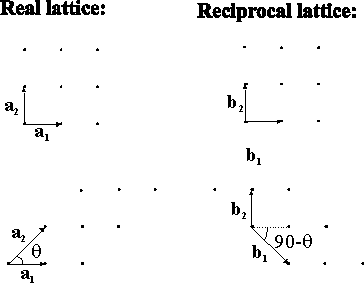Reciprocal Lattice
The reciprocal lattice represents the Fourier transform of another lattice (usually a Bravais lattice). In normal usage, the initial lattice (whose transform is represented by the reciprocal lattice) is usually a periodic spatial function in real-space and is also known as the direct lattice. While the direct lattice exists in real-space and is what one would commonly understand as a physical lattice, the reciprocal lattice exists in reciprocal space (also known as momentum space or less commonly as K-space, due to the relationship between the Pontryagin duals momentum and position). The reciprocal of a reciprocal lattice is the original direct lattice, since the two are Fourier transforms of each other. Mathematically, direct and reciprocal lattice vectors represent covariant and contravariant vectors, respectively.
The reciprocal lattice plays a very fundamental role in most analytic studies of periodic structures, particularly in the theory of diffraction. In neutron and X-ray diffraction, due to the Laue conditions, the momentum difference between incoming and diffracted X-rays of a crystal is a reciprocal lattice vector. The diffraction pattern of a crystal can be used to determine the reciprocal vectors of the lattice. Using this process, one can infer the atomic arrangement of a crystal.

